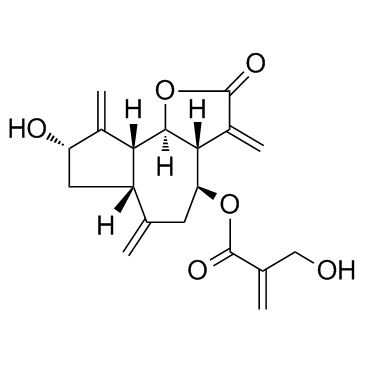Cynaropicrin |
| Katalog-Nr.GC33330 |
Cynaropicrin ist ein Sesquiterpenlacton, das die Freisetzung des Tumornekrosefaktors (TNF-α) mit IC50-Werten von 8,24 bzw. 3,18 μM fÜr murine bzw. menschliche Makrophagenzellen hemmen kann. Cynaropicrin hemmt auch den Anstieg des Knorpelabbaufaktors (MMP13) und unterdrÜckt die NF-κB-SignalÜbertragung.
Products are for research use only. Not for human use. We do not sell to patients.

Cas No.: 35730-78-0
Sample solution is provided at 25 µL, 10mM.
Cynaropicrin is a sesquiterpene lactone which can inhibit tumor necrosis factor (TNF-α) release with IC50s of 8.24 and 3.18 μM for murine and human macrophage cells, respectively. Cynaropicrin also inhibits the increase of cartilage degradation factor (MMP13) and suppresses NF-κB signaling.
Cynaropicrin strongly inhibits lipopolysaccharide-induced TNF-α release from either murine or human macrophage cells in a dose-dependent manner with the IC50 values of 8.24 and 3.18 μM, respectively. Cynaropicrin shows significant inhibitory effects toward all mitogenic signals with the IC50 values of 1.20 (concanavalin A), 1.02 (phytohemagglutinin) and 0.90 μM (lipopolysaccharide), respectively. Cynaropicrin suppresses CTLL-2 cell proliferation in a dose-dependent manner and the 50% inhibitory concentration (IC50) of Cynaropicrin for CTLL-2 cell growth is 0.91 μM[1]. The increased mRNA expression of MMP13 induced by TNF-α is similarly inhibited in a concentration-dependent manner by Cynaropicrin. The increased mRNA expression of HIF-2α induced by IL-1β in SW1353 is inhibited in a concentration-dependent manner by Cynaropicrin[2].
[1]. Cho JY, et al. In vitro anti-inflammatory effects of cynaropicrin, a sesquiterpene lactone, from Saussurea lappa. Eur J Pharmacol. 2000 Jun 23;398(3):399-407. [2]. Masutani T, et al. Cynaropicrin is dual regulator for both degradation factors and synthesis factors in the cartilage metabolism. Life Sci. 2016 Aug 1;158:70-7. [3]. da Silva CF, et al. Activities of psilostachyin A and cynaropicrin against Trypanosoma cruzi in vitro and in vivo. Antimicrob Agents Chemother. 2013 Nov;57(11):5307-14.
Average Rating: 5 (Based on Reviews and 9 reference(s) in Google Scholar.)
GLPBIO products are for RESEARCH USE ONLY. Please make sure your review or question is research based.
Required fields are marked with *




















